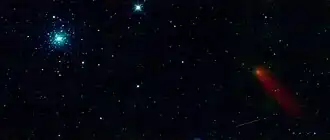C/2008 Q3 (Garradd)
 | |
| Discovery[2] | |
|---|---|
| Discovered by | Gordon J. Garradd |
| Discovery site | Siding Spring Observatory |
| Discovery date | 27 August 2008 |
| Orbital characteristics[3] | |
| Epoch | 27 August 2009 (JD 2455070.5) |
| Observation arc | 431 days (1.18 years) |
| Number of observations | 701 |
| Aphelion | ~17,780 AU |
| Perihelion | 1.798 AU |
| Semi-major axis | ~8,900 AU |
| Eccentricity | 0.99979 |
| Orbital period | ~840,000 years |
| Inclination | 140.71° |
| 219.73° | |
| Argument of periapsis | 340.86° |
| Mean anomaly | 0.0001° |
| Last perihelion | 23 June 2009 |
| TJupiter | –1.286 |
| Earth MOID | 0.814 AU |
| Jupiter MOID | 2.561 AU |
| Physical characteristics[4] | |
Mean diameter | 6.7 km (4.2 mi) |
| Comet total magnitude (M1) | 6.3 |
| Comet nuclear magnitude (M2) | 12.8 |
Comet Garradd, formally designated as C/2008 Q3, is a non-periodic comet that was observed from August 2008 to June 2010. It is the 11th out of 17 comets discovered by Australian astronomer, Gordon J. Garradd.
Physical characteristics
Infrared and spectroscopic observations by the Herschel Space Telescope determined that while the comet was around 1.83–1.85 AU (274–277 million km) from the Sun, its water production rate was measured at 1.7–2.8×1028/s-1.[5] Data obtained by Akari detected a relatively high CO/CO
2 ratio for such a dynamically new comet, which may be caused by an outburst event prior to being observed by the satellite itself.[6]
Its nucleus is estimated to have an effective diameter of 6.7 km (4.2 mi),[4] with a mass roughly about 1×1012 kg (2.2×1012 lb).[7]
References
- ^ "PIA12985: M3 & Comet Garradd". jpl.nasa.gov. NASA / Jet Propulsion Laboratory. 26 March 2010. Retrieved 5 March 2023.
- ^ G. J. Garradd; A. C. Gilmore; P. M. Kilmartin (28 August 2008). D. W. Green (ed.). "Comet C/2008 Q3 (Garradd)". IAU Circular. 8968 (1). Bibcode:2008IAUC.8968....1G.
- ^ "C/2008 Q3 (Garradd) – JPL Small-Body Database Lookup". ssd.jpl.nasa.gov. Jet Propulsion Laboratory. Retrieved 31 July 2025.
- ^ a b O. H. Pinto; M. Womack; Y. R. Fernandez; J. Bauer (2022). "A Survey of CO, CO
2, and H
2O in Comets and Centaurs". The Planetary Science Journal. 3 (11): 247–275. arXiv:2209.09985. Bibcode:2022PSJ.....3..247H. doi:10.3847/PSJ/ac960d. - ^ P. Hartogh; J. Crovisier; M. de Val-Borro; D. Bockelée-Morvan; N. Biver; et al. (2010). "HIFI observations of water in the atmosphere of comet C/2008 Q3 (Garradd)" (PDF). Astronomy & Astrophysics. 515: 150–155. arXiv:1005.2969. Bibcode:2010A&A...518L.150H. doi:10.1051/0004-6361/201014665.
- ^ T. Ootsubo; H. Kawakita; S. Hamada; H. Kobayashi; M. Hamaguchi; et al. (2012). "AKARI Near-infrared Spectroscopic Survey for CO
2 in 18 Comets". The Astrophysical Journal. 752 (1): 15–27. Bibcode:2012ApJ...752...15O. doi:10.1088/0004-637X/752/1/15. - ^ S. Szutowicz; G. Sitarski; D. Bockelee-Morvan; J. Crovisier; et al. (20–24 September 2010). Non-Gravitational Effects and Activity of Comet C/2006 W3 (Christensen) and C/2008 Q3 (Garradd) (PDF). European Planetary Science Congress. Rome, Italy. Bibcode:2010epsc.conf..793S.
External links
- C/2008 Q3 at the JPL Small-Body Database
- C/2008 Q3 at Seiichi Yoshida's website

.png)